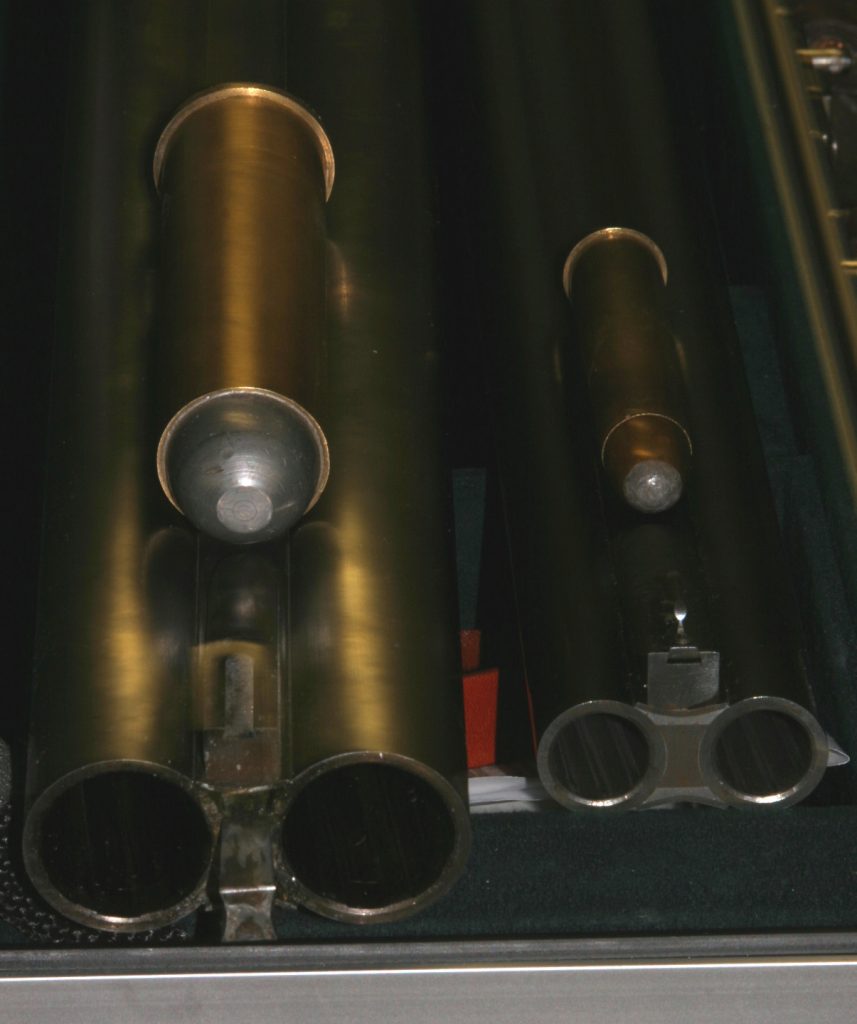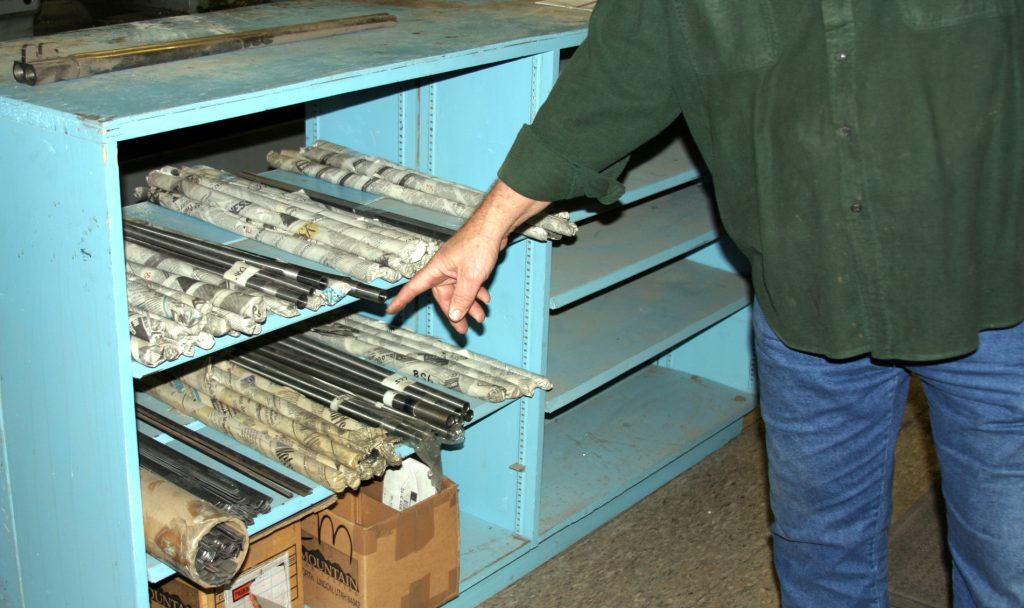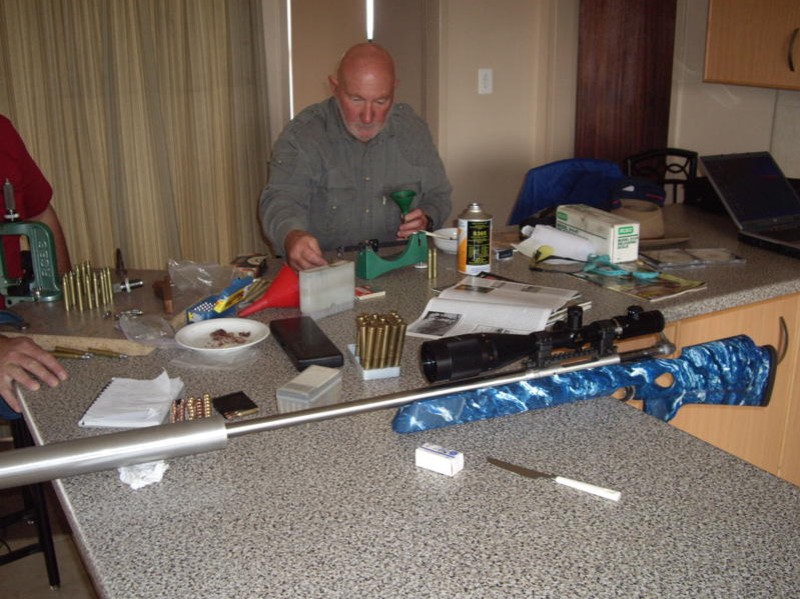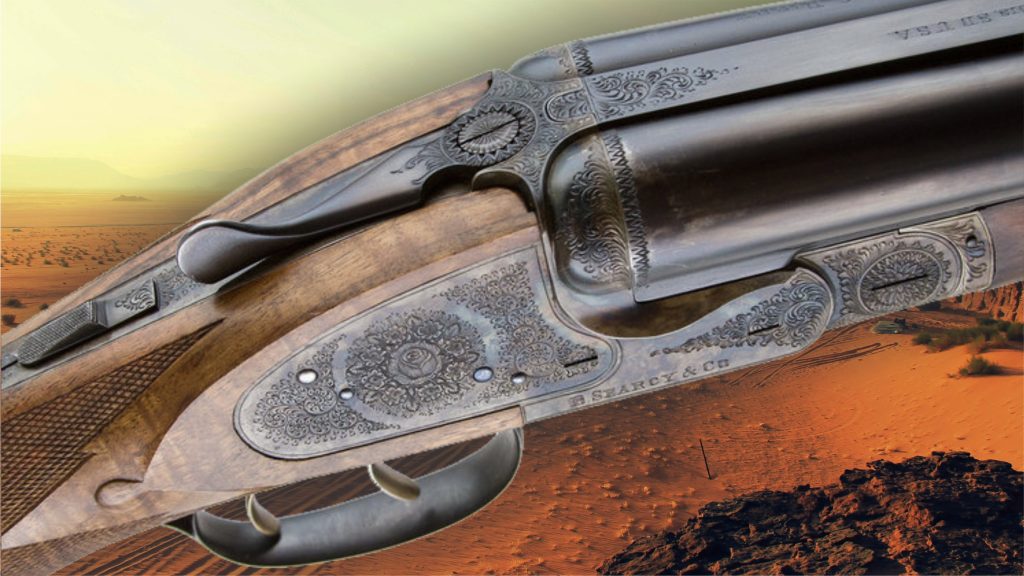 B. Searcy Company is headquartered in the small desert community of Boron, California, about 100 miles northeast of Los Angeles. Located in an old WWII Quonset building, just across the road from Edward’s Air Force Base, Searcy is ready to kit-up and custom fit a double enthusiast with a custom double barreled rifle in any caliber they are willing to pay for.
B. Searcy Company is headquartered in the small desert community of Boron, California, about 100 miles northeast of Los Angeles. Located in an old WWII Quonset building, just across the road from Edward’s Air Force Base, Searcy is ready to kit-up and custom fit a double enthusiast with a custom double barreled rifle in any caliber they are willing to pay for.
Butch offers six grades of double rifles: four boxlock designs and two sidelock designs. The Field Grade is the entry-level boxlock, which as of January 1, 2010, will have a base price of $11,500.
The next step up is the Classic boxlock at $18,000, then the Deluxe boxlock at $21,500, and the Sidelock at $22,000. Finally, there are the ultimate stoppers; a .577 Nitro Express double that you can have as a Boxlock or a Sidelock for $22,000 and $35,000 respectively (larger calibers available).
All these rifles have multiple options and feature choices, the details of which can be best viewed at Searcy’s website.
Standard calibers offered are the .375 H&H Flanged Magnum, the .450-400-3” (.411”), the .450 3¼” Nitro Express, the .450 Nitro Express, the .470 Nitro Express, the .500 Nitro Express (3” and 3 ¼”), the .577 Nitro Express, the .600 Nitro Express, the .700 Nitro Express, and the incredible 4-Bore. The 4-Bore double rifle starts at $85,000. Other calibers are available on request for an additional charge.

Only the Searcy double rifle can be described as an ‘All American’. Although other available doubles may be assembled in the United States, they are built on German or Italian actions. The Searcy rifles are machined right here in the States and have Anson and Deeley style receivers, with double Purdey bolting and top extension, and are CNC machined out of 4130 chromoly and 416 stainless steel bar stock into boxlock or sidelock configurations.

Searcy’s doubles come fitted with monobloc constructed PAC-NOR barrels, and are topped with iron sights from New England Custom Guns. A second set of double rifle barrels in a different caliber will set you back a cool $10,000, while a set of 12 gauge shotgun barrels can be fitted for a mere $4500.
Final barrel options include the choice of installing ejectors ($1000) or extractors (including rimless).
All Searcy rifles come standard with a quarter-rib, which includes one fixed rear sight and a caterpillar front sight. However, rear sights with folding leafs are available options at the rate of: one fixed + one folding leaf $400, one fixed sight + two folding leafs $500, and one fixed sight + three folding leafs $600. The final iron sight option is a front ‘night sight’ for $225.

Although not usually recommended for the larger ‘stopping’ caliber rifles, scope mounts are a popular option for the large medium bore caliber rifles, where a good quality riflescope can be very useful for long distance shots at plains game. Two styles of mounts are available; the renowned Talley rings and bases for $595 or the European style claw mounts for $2900.
To most traditionalists, red dot sights on double rifles are inconceivable. However, to a growing number of riflemen, they are a welcome addition to their sighting options. If you have vision issues that make the use of regular iron sights difficult, a lightweight red dot style sight is just the ticket for close shots where quick handling and accurate bullet placement is more important than traditional good looks.
Any level of engraving and fancy metal work can be had on request. The depth of a shooter’s pocketbook is the only limit to the amount of decoration and embellishment available. To give the engravers additional working area, $1000 false side plates are offered for the boxlock rifles.
All of these doubles come with custom-fitted stocks in various grades of English walnut from Jim Preslick.

Besides fitting (length, bend or drop, and cast-on or cast-off), other options on stocks include; long tangs ($1500), long trigger guard ($800), trap grip cap ($550), stock medallion ($400), teardrop medallion ($500), and leather covered recoil pad ($400. And finally, for $1500, all rifles can be had in an oak & leather display case.
When you consider the entry-level Holland & Holland .470 double rifle at almost $80,000 and a Westley Richards sidelock at just over $96,000, a Searcy sidelock at $22,000 certainly does look like one of the best deals on this planet for a custom double.
However, there will soon be a new higher dollar rifle rolling out from Searcy’s shop. Built on the expensive to manufacture, but robust action that John Rigby and Thomas Bissell patented in 1879; the Sidelock Bissell Rising Third Bite action’s initial price will be $40,000.
A couple of years ago, I had the good fortune to make my own pilgrimage to Butch’s legendary Quonset hut on 20 Mule Team Road in the company of .470 reloading guru, Leo Grizzaffi. As an old friend and customer of the B. Searcy Company, Leo had been asked by Butch to help him wring out a (then) new project, which consisted of fitting an extra set of 375 Flanged barrels to his well worn and well broken-in .470 Nitro Express.
This barrel combination has proven popular for many safari hunters who already own a double rifle in one of the heavy ‘stopping calibers’, i.e., a .45 caliber or larger. However, there are always other factors to consider when deciding on the caliber of your add-on barrel set. At that time, .375 Flanged brass was easier to find than .450/400 brass, but with Hornady’s recently introduced 3-inch and 3½-inch .450/400 brass now in production, getting .450/400 brass may no longer be a problem.
When I questioned Butch and Leo on the desirability of a .375 Flanged barrels vs. a set of barrels in .450/400, we got into the other issues which had led them into choosing the .375 Flanged. The deciding factors were; there is a large variety (and ample supply) of .375 caliber bullets available for handloading, and with its longer range and somewhat flatter trajectory, the .375 Flanged is more versatile in the field than the .450/400.
However, the final reason for going with the .375 Flanged was that the .450/400 simply was not a big enough step DOWN in power. With its significant reduction in recoil, the average person will find the .375 Flanged not only more pleasant to shoot, but more manageable than the .450/400. Even for someone like Leo, who has put over 5000 rounds through his .470, and over 2000 rounds through the .375 Flanged barrels, tailoring the amount of recoil down to more manageable levels was a major point. On a practical level, if the rifle is pleasant to shoot, more practice is done on a regular basis. That way, the shooter develops familiarity with the weapon, muscle memory is enhanced, and when it comes time for serious use, fear of recoil becomes a non-issue, with handling and reloading the rifle become second nature.
On the other end of the spectrum are the extreme big bore double rifles that Searcy makes, which start with the .577 Nitro Express and include the .600 Nitro Express, the .700 Nitro Express, and the massive 4-Bore. If you are not completely insensitive to recoil, the best thing you can do is stay on the porch, because recoil is where these big dogs run.

As a bonus for traditionalists, Butch also offers the dynamic duo of stopping calibers: the .450 Nitro Express and the .450 3¼” Nitro Express. These cartridges give the handloader the ability to use relatively cheap, and easily available .458 bullets to make premium ‘full-house’ hunting rounds, as well as use cast lead .458 bullets for ‘reduced load’ practice rounds.
It is not a problem if you own a modern rifle like a Searcy, but if you are going to handload full-house loads for any of the old original .450 Nitro Expresses, you should have a good gunsmith check the rifles out thoroughly, and remember to keep the pressures low. Inexpensive bullets and low recoil practice are an attractive combination of features in favor of choosing these calibers.

The 450 Nitro Express calibers were the first of their kind, and when it came out, it was viewed by many experts as the best in its class for hunting the most dangerous game. Guess what? It still is.
Having a custom double rifle maker like Searcy working right here in our back yard is a boon to the American customers who are in the market for a brand new double, and want something better than an ‘out of the box’ factory rifle.
Not only are his prices competitive with the factory doubles from Germany and France, but you are dealing with an honest US gun maker who is not only easily available, but willing to back up his product, and in most cases offer quicker delivery times.
If price is no option, and sending your rifle back to England for repairs is not inconvenient, then it is hard to argue with anyone who wants to buy a Holland and Holland or Westley Richard. However, in my opinion there is a lot of value for the first time double rifle owner to get into the game at roughly 25% of the big name English rifle makers entry level prices for doubles.
 But at the end of the day, it is up to the individual buyer to weigh their own needs and opinions against what is available on the market today, and to decide for themselves what rifle brand best fits their budget, investment strategy, and expectations.
But at the end of the day, it is up to the individual buyer to weigh their own needs and opinions against what is available on the market today, and to decide for themselves what rifle brand best fits their budget, investment strategy, and expectations.
We are lucky to have the choice of a wide range of styles in double rifle design and cosmetics available in the in the 21st Century marketplace.
It wasn’t that long age when all the firearms pundits were convinced the double rifle had seen its last safari, but in a relatively short period of time, and despite the recent downturn in the US economy, double rifle sales have rebounded from their ‘death’ in the 1960’s, and looking at their sales in the long term, we are in the strongest market for double rifles since World War II.

